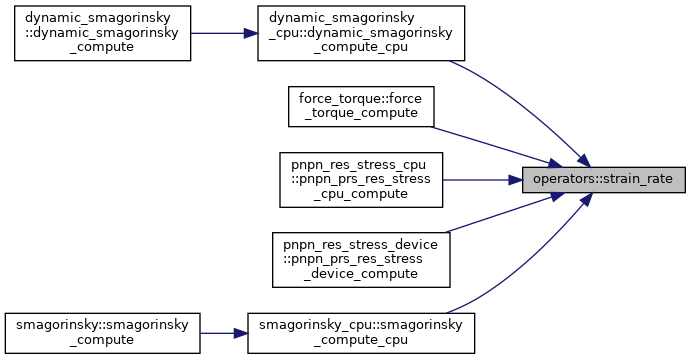Operators.
Data Types | |
| interface | rotate_cyc |
Functions/Subroutines | |
| subroutine, public | dudxyz (du, u, dr, ds, dt, coef) |
| Compute derivative of a scalar field along a single direction. | |
| subroutine, public | div (res, ux, uy, uz, coef) |
| Compute the divergence of a vector field. | |
| subroutine, public | grad (ux, uy, uz, u, coef) |
| Compute the gradient of a scalar field. | |
| subroutine, public | opgrad (ux, uy, uz, u, coef, es, ee) |
| Compute the weak gradient of a scalar field, i.e. the gradient multiplied by the mass matrix. | |
| subroutine, public | ortho (x, glb_n_points, n) |
| Othogonalize with regard to vector (1,1,1,1,1,1...,1)^T. | |
| subroutine, public | cdtp (dtx, x, dr, ds, dt, coef, es, ee) |
| Apply D^T to a scalar field, where D is the derivative matrix. | |
| subroutine, public | conv1 (du, u, vx, vy, vz, xh, coef, es, ee) |
| Compute the advection term. | |
| subroutine | convect_scalar (du, u, cr, cs, ct, xh_gll, xh_gl, coef_gll, coef_gl, gll_to_gl) |
| Apply the convecting velocity c to the to the scalar field u, used in the OIFS scheme. | |
| subroutine, public | curl (w1, w2, w3, u1, u2, u3, work1, work2, coef, event) |
| real(kind=rp) function, public | cfl (dt, u, v, w, xh, coef, nelv, gdim) |
| real(kind=rp) function, public | cfl_compressible (dt, max_wave_speed, xh, coef, nelv, gdim) |
| subroutine, public | strain_rate (s11, s22, s33, s12, s13, s23, u, v, w, coef) |
| Compute the strain rate tensor, i.e 0.5 * du_i/dx_j + du_j/dx_i. | |
| subroutine, public | lambda2op (lambda2, u, v, w, coef) |
| Compute the Lambda2 field for a given velocity field. | |
| subroutine, public | set_convect_rst (cr, cs, ct, cx, cy, cz, xh, coef) |
| Transforms the convecting velocity field to the rst form of the GL space. | |
| subroutine, public | runge_kutta (phi, conv_k1, conv_k23, conv_k4, xh_gll, xh_gl, coef, coef_gl, gll_to_gl, tau, dtau, n, nel, n_gl) |
| Compute one step of Runge Kutta time interpolation for OIFS scheme. | |
| subroutine | rotate_cyc_r1 (vx, vy, vz, idir, coef) |
| subroutine | rotate_cyc_r4 (vx, vy, vz, idir, coef) |
Function/Subroutine Documentation
◆ cdtp()
| subroutine, public operators::cdtp | ( | real(kind=rp), dimension(coef%xh%lxyz, coef%msh%nelv), intent(inout) | dtx, |
| real(kind=rp), dimension(coef%xh%lxyz, coef%msh%nelv), intent(inout) | x, | ||
| real(kind=rp), dimension(coef%xh%lxyz, coef%msh%nelv), intent(in) | dr, | ||
| real(kind=rp), dimension(coef%xh%lxyz, coef%msh%nelv), intent(in) | ds, | ||
| real(kind=rp), dimension(coef%xh%lxyz, coef%msh%nelv), intent(in) | dt, | ||
| type(coef_t), intent(in) | coef, | ||
| integer, optional | es, | ||
| integer, optional | ee | ||
| ) |
- Parameters
-
dtx Will store the result. x The values of the field. dr The derivative of r with respect to the chosen direction. ds The derivative of s with respect to the chosen direction. dt The derivative of t with respect to the chosen direction. coef The SEM coefficients. es Starting element index, optional, defaults to 1. ee Ending element index, optional, defaults to nelv.
- Note
- This needs to be revised... the loop over n1,n2 is probably unesccssary
Definition at line 249 of file operators.f90.


◆ cfl()
| real(kind=rp) function, public operators::cfl | ( | real(kind=rp), intent(in) | dt, |
| real(kind=rp), dimension(xh%lx, xh%ly, xh%lz, nelv), intent(in) | u, | ||
| real(kind=rp), dimension(xh%lx, xh%ly, xh%lz, nelv), intent(in) | v, | ||
| real(kind=rp), dimension(xh%lx, xh%ly, xh%lz, nelv), intent(in) | w, | ||
| type(space_t), intent(in) | xh, | ||
| type(coef_t), intent(in) | coef, | ||
| integer, intent(in) | nelv, | ||
| integer, intent(in) | gdim | ||
| ) |
Definition at line 426 of file operators.f90.


◆ cfl_compressible()
| real(kind=rp) function, public operators::cfl_compressible | ( | real(kind=rp), intent(in) | dt, |
| real(kind=rp), dimension(xh%lx, xh%ly, xh%lz, nelv), intent(in) | max_wave_speed, | ||
| type(space_t), intent(in) | xh, | ||
| type(coef_t), intent(in) | coef, | ||
| integer, intent(in) | nelv, | ||
| integer, intent(in) | gdim | ||
| ) |
Definition at line 457 of file operators.f90.


◆ conv1()
| subroutine, public operators::conv1 | ( | real(kind=rp), dimension(xh%lxyz, coef%msh%nelv), intent(inout) | du, |
| real(kind=rp), dimension(xh%lx, xh%ly, xh%lz, coef%msh%nelv), intent(inout) | u, | ||
| real(kind=rp), dimension(xh%lx, xh%ly, xh%lz, coef%msh%nelv), intent(inout) | vx, | ||
| real(kind=rp), dimension(xh%lx, xh%ly, xh%lz, coef%msh%nelv), intent(inout) | vy, | ||
| real(kind=rp), dimension(xh%lx, xh%ly, xh%lz, coef%msh%nelv), intent(inout) | vz, | ||
| type(space_t), intent(in) | xh, | ||
| type(coef_t), intent(in) | coef, | ||
| integer, optional | es, | ||
| integer, optional | ee | ||
| ) |
- Parameters
-
du Holds the result. u The advected field. vx The x component of the advecting velocity. vy The y component of the advecting velocity. vz The z component of the advecting velocity. Xh The function space for the fields involved. coef The SEM coefficients. es Starting element index, defaults to 1. ee Last element index, defaults to mesh size.
Definition at line 293 of file operators.f90.


◆ convect_scalar()
|
private |
- Parameters
-
du Holds the result cr The r-component of convecting velocity cs The s-component of convecting velocity ct The t-component of convecting velocity u The convected scalar field Xh_GLL The GLL space used in simulation Xh_GL The GL space used for dealiasing coef The coefficients of the original space in simulation coef_GL The coefficients of the GL space used for dealiasing GLL_to_GL the interpolator between the GLL and GL spaces
- Note
- This subroutine is equal to the convop_fst_3d of the NEK5000.
- This subroutine is used specifically in the OIFS scheme, calculateing eq(17) in https://publications.anl.gov/anlpubs/2017/12/140626.pdf. The convecting term is calculated in the rst format and the GL grid. Then converted back to the GLL grid, going through an ADD gatter scatter operation at the element boundaries, before being multiplied by inverse of mass matrix.
Definition at line 347 of file operators.f90.

◆ curl()
| subroutine, public operators::curl | ( | type(field_t), intent(inout) | w1, |
| type(field_t), intent(inout) | w2, | ||
| type(field_t), intent(inout) | w3, | ||
| type(field_t), intent(in) | u1, | ||
| type(field_t), intent(in) | u2, | ||
| type(field_t), intent(in) | u3, | ||
| type(field_t), intent(inout) | work1, | ||
| type(field_t), intent(inout) | work2, | ||
| type(coef_t), intent(in) | coef, | ||
| type(c_ptr), intent(inout), optional | event | ||
| ) |
◆ div()
| subroutine, public operators::div | ( | real(kind=rp), dimension(coef%xh%lx, coef%xh%ly, coef%xh%lz, coef%msh%nelv), intent(inout) | res, |
| real(kind=rp), dimension(coef%xh%lx, coef%xh%ly, coef%xh%lz, coef%msh%nelv), intent(in) | ux, | ||
| real(kind=rp), dimension(coef%xh%lx, coef%xh%ly, coef%xh%lz, coef%msh%nelv), intent(in) | uy, | ||
| real(kind=rp), dimension(coef%xh%lx, coef%xh%ly, coef%xh%lz, coef%msh%nelv), intent(in) | uz, | ||
| type(coef_t), intent(in), target | coef | ||
| ) |
- Parameters
-
res Holds the resulting divergence values. ux The x component of the vector field. uy The y component of the vector field. uz The z component of the vector field. coef The SEM coefficients.
Definition at line 114 of file operators.f90.

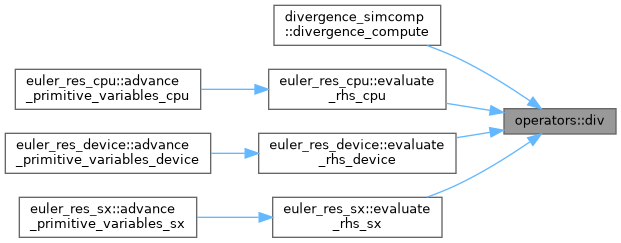
◆ dudxyz()
| subroutine, public operators::dudxyz | ( | real(kind=rp), dimension(coef%xh%lx, coef%xh%ly, coef%xh%lz, coef%msh%nelv), intent(inout) | du, |
| real(kind=rp), dimension(coef%xh%lx, coef%xh%ly, coef%xh%lz, coef%msh%nelv), intent(in) | u, | ||
| real(kind=rp), dimension(coef%xh%lx, coef%xh%ly, coef%xh%lz, coef%msh%nelv), intent(in) | dr, | ||
| real(kind=rp), dimension(coef%xh%lx, coef%xh%ly, coef%xh%lz, coef%msh%nelv), intent(in) | ds, | ||
| real(kind=rp), dimension(coef%xh%lx, coef%xh%ly, coef%xh%lz, coef%msh%nelv), intent(in) | dt, | ||
| type(coef_t), intent(in), target | coef | ||
| ) |
- Parameters
-
du Holds the resulting derivative values. u The values of the field. dr The derivative of r with respect to the chosen direction. ds The derivative of s with respect to the chosen direction. dt The derivative of t with respect to the chosen direction. coef The SEM coefficients.
Definition at line 89 of file operators.f90.
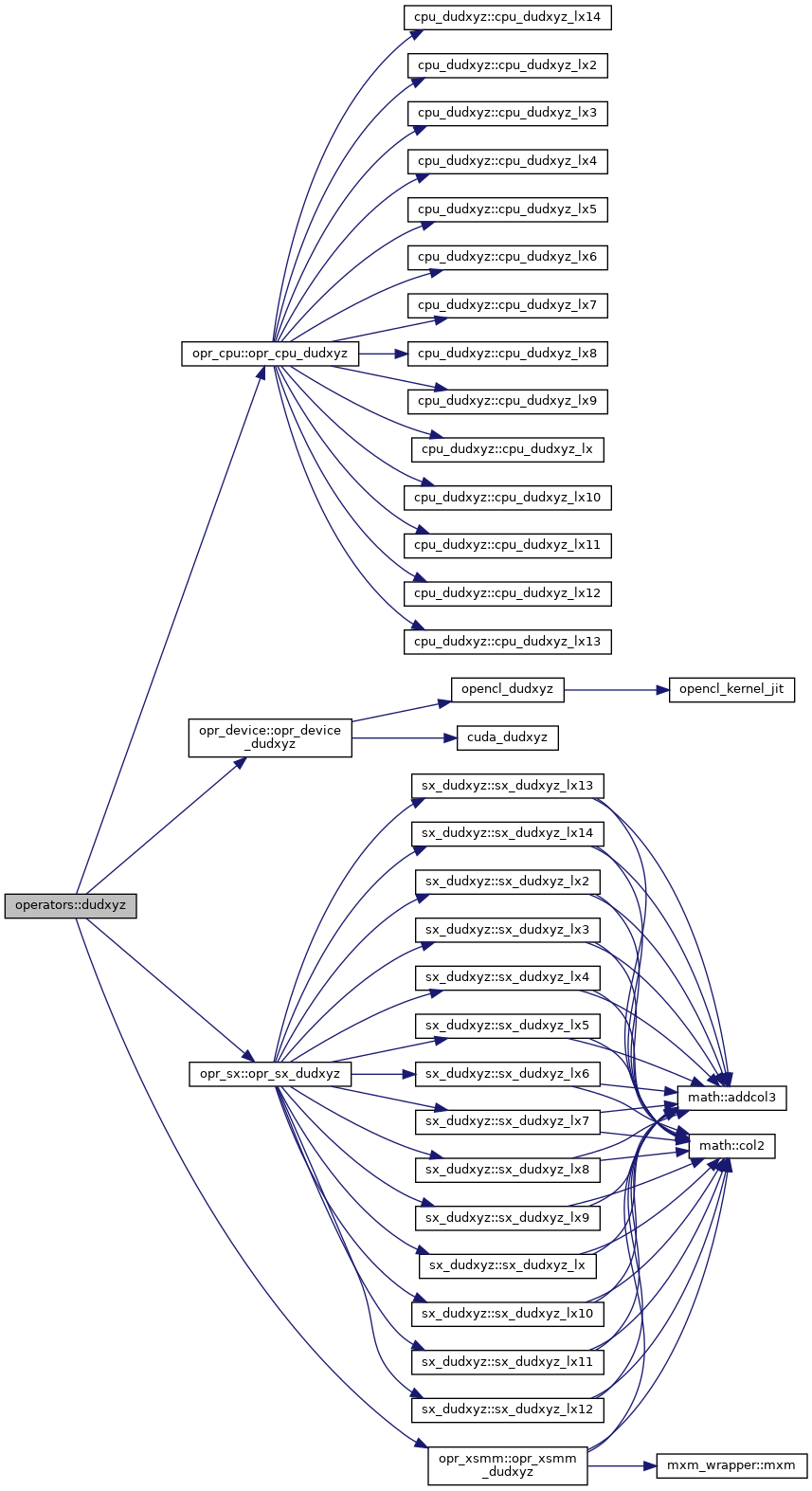

◆ grad()
| subroutine, public operators::grad | ( | real(kind=rp), dimension(coef%xh%lxyz, coef%msh%nelv), intent(inout) | ux, |
| real(kind=rp), dimension(coef%xh%lxyz, coef%msh%nelv), intent(inout) | uy, | ||
| real(kind=rp), dimension(coef%xh%lxyz, coef%msh%nelv), intent(inout) | uz, | ||
| real(kind=rp), dimension(coef%xh%lxyz, coef%msh%nelv), intent(in) | u, | ||
| type(coef_t), intent(in) | coef | ||
| ) |
- Parameters
-
ux Will store the x component of the gradient. uy Will store the y component of the gradient. uz Will store the z component of the gradient. u The values of the field. coef The SEM coefficients.
Definition at line 159 of file operators.f90.


◆ lambda2op()
| subroutine, public operators::lambda2op | ( | type(field_t), intent(inout) | lambda2, |
| type(field_t), intent(in) | u, | ||
| type(field_t), intent(in) | v, | ||
| type(field_t), intent(in) | w, | ||
| type(coef_t), intent(in) | coef | ||
| ) |
- Parameters
-
lambda2 Holds the computed Lambda2 field. u The x-velocity. v The y-velocity. w the z-velocity. coef The SEM coefficients.
Definition at line 569 of file operators.f90.

◆ opgrad()
| subroutine, public operators::opgrad | ( | real(kind=rp), dimension(coef%xh%lxyz, coef%msh%nelv), intent(inout) | ux, |
| real(kind=rp), dimension(coef%xh%lxyz, coef%msh%nelv), intent(inout) | uy, | ||
| real(kind=rp), dimension(coef%xh%lxyz, coef%msh%nelv), intent(inout) | uz, | ||
| real(kind=rp), dimension(coef%xh%lxyz, coef%msh%nelv), intent(in) | u, | ||
| type(coef_t), intent(in) | coef, | ||
| integer, optional | es, | ||
| integer, optional | ee | ||
| ) |
By providing es and ee, it is possible to compute only for a range of element indices.
- Parameters
-
ux Will store the x component of the gradient. uy Will store the y component of the gradient. uz Will store the z component of the gradient. u The values of the field. coef The SEM coefficients. es Starting element index, optional, defaults to 1. ee Ending element index, optional, defaults to nelv.
- Note
- Equals wgradm1 in Nek5000, the weak form of the gradient.
Definition at line 184 of file operators.f90.

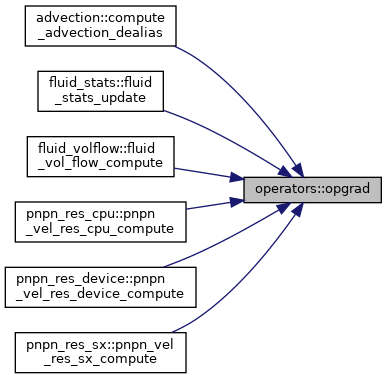
◆ ortho()
| subroutine, public operators::ortho | ( | real(kind=rp), dimension(n), intent(inout) | x, |
| integer(kind=i8), intent(in) | glb_n_points, | ||
| integer, intent(in) | n | ||
| ) |
- Parameters
-
x The vector to orthogonolize. glb_n_points The global number of non-unique gll points in the grid.
- Note
- This is equivalent to subtracting the mean of
xfrom each of its elements.
Definition at line 221 of file operators.f90.
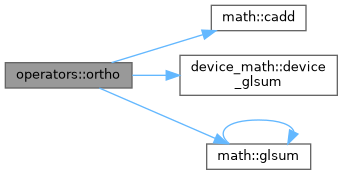
◆ rotate_cyc_r1()
|
private |
Definition at line 749 of file operators.f90.
◆ rotate_cyc_r4()
|
private |
Definition at line 762 of file operators.f90.
◆ runge_kutta()
| subroutine, public operators::runge_kutta | ( | type(field_t), intent(inout) | phi, |
| type(field_list_t) | conv_k1, | ||
| type(field_list_t) | conv_k23, | ||
| type(field_list_t) | conv_k4, | ||
| type(space_t), intent(in) | xh_gll, | ||
| type(space_t), intent(inout) | xh_gl, | ||
| type(coef_t), intent(in) | coef, | ||
| type(coef_t), intent(inout) | coef_gl, | ||
| type(interpolator_t) | gll_to_gl, | ||
| real(kind=rp), intent(inout) | tau, | ||
| real(kind=rp), intent(inout) | dtau, | ||
| integer, intent(in) | n, | ||
| integer, intent(in) | nel, | ||
| integer, intent(in) | n_gl | ||
| ) |
- Parameters
-
phi The iterpolated field conv_k1 The covecting velocity for the first stage conv_k23 The convecting velocity for the second and third stage conv_k4 The convecting velocity for the fourth stage Xh_GLL The GLL space used in simulation Xh_GL The GL space used for dealiasing coef The coefficients of the original space in simulation coef_GL The coefficients of the GL space used for dealiasing GLL_to_GL the interpolator between the GLL and GL spaces tau The the starting time dtau The time step used for the Runge Kutta scheme n size of phi nel Total number of elements n_GL the size in the GL space
Definition at line 633 of file operators.f90.


◆ set_convect_rst()
| subroutine, public operators::set_convect_rst | ( | type(field_t), intent(inout) | cr, |
| type(field_t), intent(inout) | cs, | ||
| type(field_t), intent(inout) | ct, | ||
| real(kind=rp), dimension(xh%lxyz, coef%msh%nelv), intent(in) | cx, | ||
| real(kind=rp), dimension(xh%lxyz, coef%msh%nelv), intent(in) | cy, | ||
| real(kind=rp), dimension(xh%lxyz, coef%msh%nelv), intent(in) | cz, | ||
| type(space_t), intent(inout) | xh, | ||
| type(coef_t), intent(inout) | coef | ||
| ) |
- Parameters
-
cr convecting velocity in r-direction cs convecting velocity in s-direction ct convecting velocity in t-direction cx convecting velocity in x-direction cy convecting velocity in y-direction cz convecting velocity in z-direction Xh The GL space used for dealiasing coef The coeffiecients of the GL space used for dealiasing
- Note
- This subroutine is equal to the set_convect_new subroutine of NEK5000
Definition at line 594 of file operators.f90.

◆ strain_rate()
| subroutine, public operators::strain_rate | ( | real(kind=rp), dimension(u%xh%lx, u%xh%ly, u%xh%lz, u%msh%nelv), intent(inout) | s11, |
| real(kind=rp), dimension(u%xh%lx, u%xh%ly, u%xh%lz, u%msh%nelv), intent(inout) | s22, | ||
| real(kind=rp), dimension(u%xh%lx, u%xh%ly, u%xh%lz, u%msh%nelv), intent(inout) | s33, | ||
| real(kind=rp), dimension(u%xh%lx, u%xh%ly, u%xh%lz, u%msh%nelv), intent(inout) | s12, | ||
| real(kind=rp), dimension(u%xh%lx, u%xh%ly, u%xh%lz, u%msh%nelv), intent(inout) | s13, | ||
| real(kind=rp), dimension(u%xh%lx, u%xh%ly, u%xh%lz, u%msh%nelv), intent(inout) | s23, | ||
| type(field_t), intent(in) | u, | ||
| type(field_t), intent(in) | v, | ||
| type(field_t), intent(in) | w, | ||
| type(coef_t), intent(in) | coef | ||
| ) |
- Parameters
-
s11 Will hold the 1,1 component of the strain rate tensor. s22 Will hold the 2,2 component of the strain rate tensor. s33 Will hold the 3,3 component of the strain rate tensor. s12 Will hold the 1,2 component of the strain rate tensor. s13 Will hold the 1,3 component of the strain rate tensor. s23 Will hold the 2,3 component of the strain rate tensor. u The x component of velocity. v The y component of velocity. w The z component of velocity. coef The SEM coefficients.
- Note
- Similar to comp_sij in Nek5000.
- Parameters
-
[in] w velocity components
Definition at line 496 of file operators.f90.

